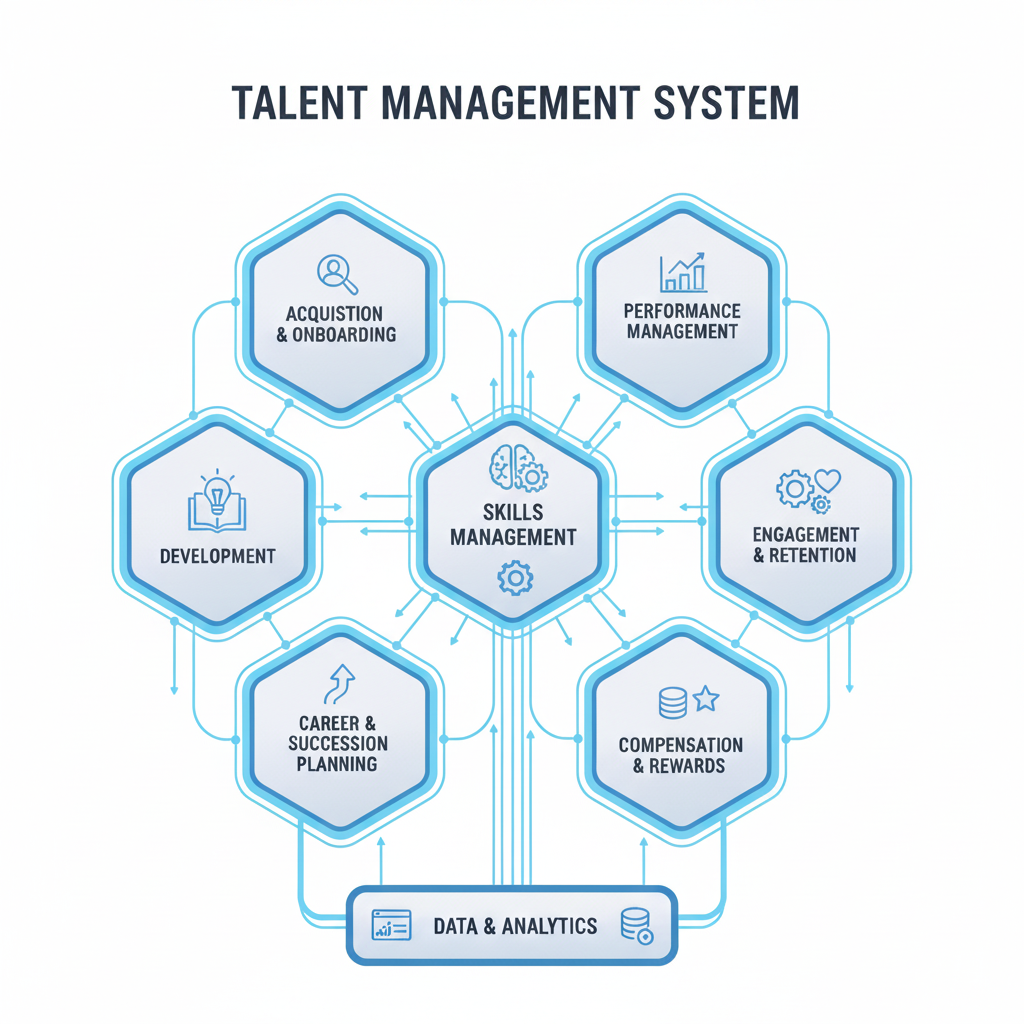What Is a Talent Management System?
A Talent Management System (TMS) is software that helps an organization plan, attract, nurture, evaluate, and retain its workforce. It integrates recruiting, onboarding, performance evaluation, learning, career planning, and succession, so leaders can make strategic decisions based on real data. Unlike older HRIS systems focused only on payroll or compliance, a modern TMS is the backbone of workforce strategy.
In this article, we explore the key components of a Talent Management System and present a real-world implementation case with measurable outcomes.
Skill Management at the heart of a modern Talent Management System
Skill management is the foundation of a modern Talent Management System, turning job data into dynamic capabilities.
With the Skill Management in Teammeter you get more precise recruiting, skill-based performance reviews, and personalized learning paths. Succession planning and workforce analytics rely on skill profiles to spot gaps and redeploy talent. Employees see clear career paths, boosting engagement and retention.

Why Talent Management is a must-have for Modern Organizations
The workplace is shifting quickly. Deloitte’s 2025 Global Human Capital Trends report highlights that organizations must become skills-based, data-driven, and adaptive to survive. Companies that invest in talent management practices are significantly more likely to exceed financial targets.
Meanwhile, the Society for Human Resource Management (SHRM) defines talent management as the practice of integrating every stage of the employee lifecycle into one strategy that fuels business performance. Without this integration, companies risk longer hiring cycles, higher turnover, and missed growth opportunities.
Key Capabilities to Look for in a Talent Management System
When evaluating solutions, focus on capabilities that touch every part of the employee experience.
🔍 Recruiting and Onboarding
Look for a system with a strong applicant tracking system, automated job posting, and structured onboarding workflows. These features reduce time-to-hire and improve first impressions.
🎯 Performance and Feedback
Modern TMS platforms offer continuous feedback, OKR tracking, and 360-degree reviews. This drives alignment and keeps employees engaged.
🎓 Learning and Development
According to the LinkedIn Workplace Learning Report, access to learning is now one of the top reasons employees stay with a company. A Talent Management System with an integrated Learning Management System helps personalize training, close skill gaps, and track compliance.
✅ Succession and Career Planning
Future-proof your workforce by mapping successors for critical roles and giving employees transparent career paths.
📈 Analytics and Insights
Today’s platforms provide dashboards with turnover trends, diversity metrics, and skill coverage. Some systems even offer predictive analytics to flag employees at risk of leaving.
🔐 Compliance and Security
Data privacy is non-negotiable. Ensure the vendor meets GDPR requirements, follows ISO/IEC 27001 standards, and has strong encryption and access controls.
Choosing the Right Talent Management System
Start by defining what problem you are solving: retention, faster hiring, career development, or succession planning. Then involve HR, IT, and line managers early in the selection process to ensure the system integrates well with your existing systems.
Run a pilot or request a sandbox environment before committing. This helps you evaluate user experience and adoption. Security and compliance, like a ISO 27001 certificate, should be part of your checklist, not an afterthought.
Talent Management Software Comparison
Find below a list of leading Talent Management Solutions on the market:
| Product | Ideal For | Key Strength | Official Link |
|---|---|---|---|
| Workday HCM | Large enterprises | Unified HCM + analytics | workday.com |
| SAP SuccessFactors | Global corporations | Localization & compliance | sap.com |
| Cornerstone | Learning-focused orgs | Powerful LMS ecosystem | cornerstoneondemand.com |
| BambooHR | SMBs | Simplicity & fast rollout | bamboohr.com |
| Teammeter | Modern enterprises | Skills + performance focus | teammeter.com |
For a more detailed comparison, look at our article about the best talent management software.
Case Study
To better understand the impact of a Talent Management System, consider this case study: a multinational manufacturer with about 5,000 employees grappling with rapid automation and digitalization that were reshaping job roles and exposing unaddressed skill gaps.
Challenge
Rapid technology change (automation, digitalization) made many current job roles demand new technical & soft skills. Performance reviews were disconnected from actual competency needs: managers often gave feedback about “learn more digital tools” but the learning paths were unclear; skill gaps were not systematically evaluated; development conversations were informal and inconsistent.
Solution
- Established a global skill taxonomy per business unit: mapping out 20-30 key technical and leadership competencies required now and projected for 2-3 years ahead.
- Rolled out a skills assessment platform: employees self-assess + manager validates . Skill data tied into Learning Management System (LMS) that suggests learning modules based on gaps.
- Aligned performance review system: managers set objectives that include both performance goals (“what”) and development goals (“what skills will I grow / demonstrate”) using the competency framework. Every performance review includes a development plan with specific skills to work on.
- Quarterly check-ins rather than just annual review so managers & employees can see progress on skills development and adjust. Performance feedback includes not just results but how they were achieved (competency / behavior aspects).
Outcomes
- Within one year, 70% of employees had completed the skills self-assessment + received personalized development paths.
- Skill gap closure: on average, competency gaps in priority skills reduced by 30% (measured via follow-up assessments).
- Employee engagement / satisfaction: development conversations scored 20% higher in satisfaction in employee surveys.
- Performance review quality: “feedback usefulness” rating up by 25%.
- Internal mobility improved: 40% more roles filled from internal candidates due to clearer visibility of skills and development.
Conclusion
A Talent Management System is no longer a “nice to have.” It is a strategic necessity. By centralizing recruiting, performance reviews, skills development, and succession planning, a TMS creates a single source of truth for talent data and aligns people strategy with business goals.
When implemented thoughtfully, it does more than automate HR processes. It transforms them. Employees gain visibility into their growth paths, managers get actionable insights into team capabilities, and leadership can make data-driven decisions about the future workforce.
In a world where skills needs are evolving faster than ever, organizations that invest in a robust TMS position themselves to attract, develop, and retain top talent and turn talent management into a competitive advantage.

